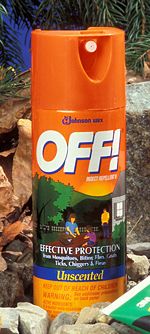Aerosol: Difference between revisions
imported>George Swan (add image) |
mNo edit summary |
||
| (2 intermediate revisions by 2 users not shown) | |||
| Line 12: | Line 12: | ||
</ref>]] | </ref>]] | ||
An '''aerosol''' is a suspension of tiny solid particles or liquid droplets in a gas. | |||
==Dangerous aerosols in industry== | ==Dangerous aerosols in industry== | ||
| Line 39: | Line 39: | ||
==Consumer products delivered as aerosols== | ==Consumer products delivered as aerosols== | ||
{{Image|Aerosol OFF bug spray.jpg|right|150px|Add image caption here.}} | |||
Some modern consumer products, like [[paint]], [[hair-spray]], [[whipping cream]], or penetrating [[lubricants]], are applied as aersols. | Some modern consumer products, like [[paint]], [[hair-spray]], [[whipping cream]], or penetrating [[lubricants]], are applied as aersols. | ||
| Line 56: | Line 56: | ||
==References== | ==References== | ||
{{reflist}} | {{reflist}}[[Category:Suggestion Bot Tag]] | ||
Latest revision as of 16:01, 6 July 2024

Fire following a dust explosion that occurred in North Carolina plant that made rubber products for the pharmaceutical industry.[1]
An aerosol is a suspension of tiny solid particles or liquid droplets in a gas.
Dangerous aerosols in industry
Some solids, suspended in air, can be dangerously explosive. Suspended coal dust in mines, or suspended flour or grain dust, in flour mills and grain elevators, can be dangerously explosive.[2][1]
Consumer products delivered as aerosols
Some modern consumer products, like paint, hair-spray, whipping cream, or penetrating lubricants, are applied as aersols. Products delivered as aerosols are typically distributed in pressurized cans, where the liquid to be delivered is pressurized by a gas called a "propellant". Air is rarely used as a propellant. Nitrous Oxide (laughing gas) is used as a propellant for edible products, like whipping cream. Some other products use light hydrocarbon gases, like butane or propane, which can pose a fire risk. In the late twentieth century chlorinated fluorocarbans were a commonly used propellant; but they are no longer used because it was found the expelled propellant was very damaging to the atmosphere's ozone layer.[3]
References
- ↑ 1.0 1.1 Combustible Dust in Industry: Preventing and Mitigating the Effects of Fire and Explosions, United States Department of Labor, January 2003. Retrieved on 2008-11-03.
- ↑ Cleate R. Stepan, P.E.. Coal Dust Eplosion Hazards, Mine Safety and Health Administration, Pittsburgh, Pennsylvania. Retrieved on 2008-11-03.
- ↑ Ozone Science: The Facts Behind the Phaseout, Environmental Protection Agency. Retrieved on 2008-11-03.
